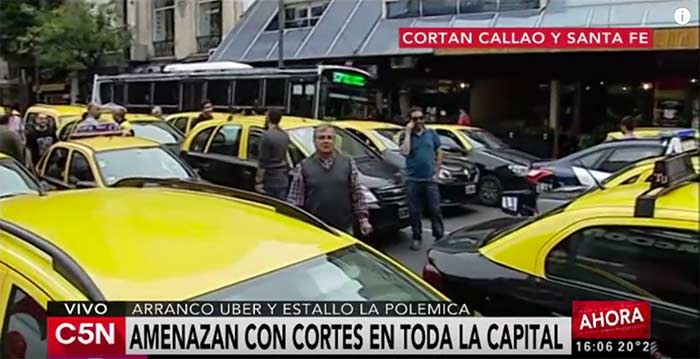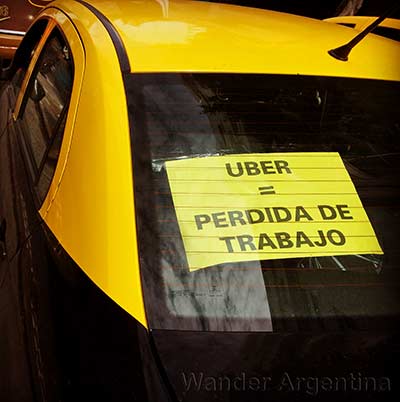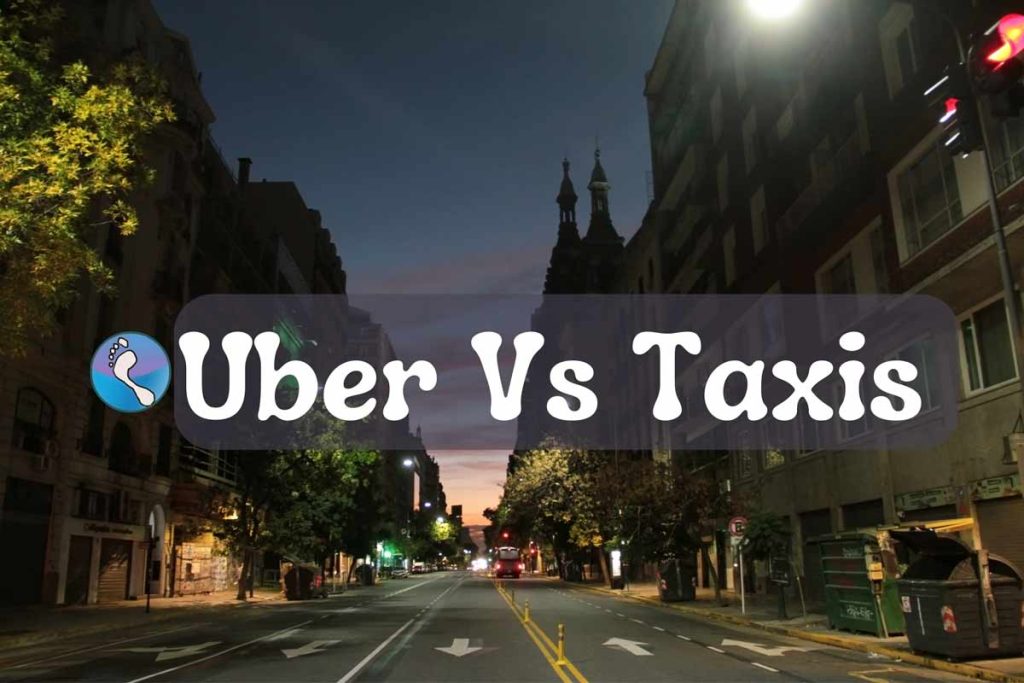Ride-hailing apps such as Uber are a popular option for visitors to Buenos Aires and other large cities in Argentina.

They are often more cost efficient and also remove some of the uncertainty or confusion that language issues can cause using a normal city taxi.
In Buenos Aires particularly, using ride services is less stressful than renting a car and driving and often faster than the bus or subway.
The main ride-sharing service that foreigners are familiar with, Uber, tended to be cheaper than taking a taxi when it was first introduce in 2016. The exception is during peak times, such as holidays that cause surge pricing.
Uber can be paid with (non-Argentine) credit card, users know the approximate cost of the trip beforehand and the app provides information about the driver, such as their name and customer rating.
This means Uber users don’t have to deal with cash and the perpetual problem of making sure one has change on hand with which to pay the driver.
Due to the blue dollar some people prefer for their ride in pesos. Drivers definitely prefer it because Argentina’s economic woes make it difficult for them to get paid by card.
Make sure you select the ‘pay in cash’ option in the app.
For those that have a credit or debit card with the favorable credit card rate, it is rather convenient but lately some are having their cards rejected by Uber.
Using the Silicon Valley-born app also cuts down on the possibility of taxi scams that include costly detours, sped-up meters or getting counterfeit bills as change.
The biggest drawback to using ride sharing apps in Argentina is that it usually takes five or ten minutes for a car to show up, while hailing a taxi (in Buenos Aires at least) is usually instantaneous.
Sometimes drivers will also cancel the ride if they see you are paying with a credit card instead of cash.
Anger Around Argentina over Uber

Buenos Aires’ taxis drivers are angry at being undercut by an unregulated service, and there have been loud protests about the app, taxi-led roadblocks.
In the beginning, there were even a few incidents of Uber drivers and passengers being mobbed by cab drivers.
The government has backed up the taxi union in the struggle. The day after the service debuted in Buenos Aires in 2015 the courts ordered the service shut down.
Uber paid a fine but due to its unregulated nature, continued to operate and even pushed back by offering the service for free for a few days.
The government then blocked Uber from processing major credit cards issued in Argentina — locals have to resort to using alternative prepaid methods (including bitcoin) or cash in order to pay for their ride.
Travelers using a foreign credit card, can pay using it, but as it explained above, because of the blue dollar it will be twice the price.

In 2018 the city of Buenos Aires voted in a law that imposes fines on Uber drivers caught using the app.
The Supreme Court later backed Uber but the service remains in legal limbo in most of Argentina and protest of ride-sharing apps continues in other cities around the country.
Some people remain loyal to taxis and not only because they are slow to warm to new technology.
Argentines sometimes view U.S. companies and technology with suspicion. The country has a strong tradition of unionization and workers’ rights.
Uber drivers are independent contractors with no benefits or labor protection. But immigrants coming to Argentina to live, especially economic migrants such as Venezuelans, are enthusiastic to work as drivers with the app.
Safety of Uber in Argentina?

For now, passengers in most of Argentina use Uber at their own risk.
Uber in Argentina has looser requirements than in some other places, particularly when it comes to the cars.
Occasional police checkpoints have been set up to crackdown on Uber drivers, which means drivers sometimes request a passenger sit in the front.
Also, it is important to note that in the case of an accident, the insurance company for the car will most likely get away with not covering Uber passengers, since the service is unregulated.
Since 2019, Uber provides additional insurance for their drivers and passengers in Argentina.
Those using Uber may want to make sure they have travel insurance.
The one exception is the city of Mendoza, where legislators have kept up with technology and thus legalized Uber in that city after a fight that went all the way to the provincial Supreme Court.
Getting Uber at Ezieza Airport
It’s worth noting that using Uber after landing at the international airport does not tend to go as smoothly as one would hope.
While the airport has free wifi, the Uber app is blocked. Even if one orders an Uber with their own data-plan they will have to walk away from the terminal, find the driver, luggage in hand, among a sea of cars.
Although a lot of the fever has died down, taxi drivers may become aggressive if they catch on that the car is an Uber. Because of this many Uber drivers avoid trips to the airport.
Those who do choose to call Uber should act like the driver is a friend and get in the front seat to avoid the wrath of any nearby taxi drivers. .
(If that prospect sounds dodgy, Wander Argentina offers safe, reliable prepaid airport pickup.)
Once you are in Buenos Aires or other cities, getting to the airport is usually not a problem. Although users should keep in mind that drivers prefer cash.
Those who have their Uber app set to withdraw from their card automatically should be aware that if the driver asks for cash, Uber will also automatically charge your card.
If one finds themselves in this predicament, take a video of the cash changing hands.
It can help to get a refund, but it will take some arguing with Uber support staff unaware of the strange quirks of the Argentina economy.

Uber Alternatives: Cabify, inDriver, Didi, Easy Taxi & BA Taxi
Since 2016, when Uber arrived to Argentina and shook up the traditional taxi and remis industry, other ride-sharing apps have come on the scene.
Cabify
The Spanish-owned Cabify is an alternative to Uber with no price surging that has more rigorous requirements for driver and cars, but it does tend to be slightly more expensive.
Cabify has become the preferred app for many foreigners in Buenos Aires.
Drivers are required to do a face-to-face interview, be registered and get a psychological test before being hired. Cabify cars are required to be newer than 10 years old.
inDriver
The newest ride sharing app on the scene is inDriver. It has various languages and reasonable prices, although sometimes the cars are older.
Didi
The Chinese ride-sharing app has been in Argentina since 2020.
It functions in major cities such as metropolitan Buenos Aires and La Plata.
One concern is Didi uses facial recognition and have been fined for harvesting biometric and other data that is beyond the cope of what is necessary for its use.
Easy Taxi
Although not ride-sharing app, Easy Taxi is a Brazilian-developed app that may be useful for travelers, as it is popular throughout Latin America.
It locates a taxi using GPS, but the fare is usually paid with cash — just a few cars accept credit cards.
It has been in the country four years and operates in Buenos Aires, Rosario and Cordoba.
BA Taxi
BA Taxi is an app that the city of Buenos Aires government rolled out in early 2017 to compete with Uber.
BA Taxi is available for download on Google Play or Apple.
It allows users to order a taxi in Buenos Aires with their smartphone and is similar to Uber, although it is for registered taxis only and the platform is only in Spanish.
BA Taxi fares can also be paid with a credit card.
Unfortunately the app has poor reviews, with taxi drivers and users saying it doesn’t open, it stalls, it’s slow — basically an Uber copy that doesn’t work well. It has improved though, so it’s worth a try if other apps aren’t working.
Lyft
The ride service Lyft is not yet available in Argentina.
Pros & Cons of Ride-sharing apps vs Traditional Taxis

With all the different apps uncomfortably co-existing with the traditional taxi, many wonder if it’s better to flag down a black and yellow with the ‘libre‘ sign lit up, or ‘hail’ a car electronically via cellphone.
One drawback to using ride-sharing apps over traditional taxis hailed on the street in Buenos Aires and other large cities is that users have to take out their cellphones.
This can make tourists susceptible to a snatch and grab robbery of the phone.
Unlike most taxis hailed on the street, they can also be paid with credit cards.
Taxis can be hailed on the street in Buenos Aires, although with a little more difficulty these days as ride apps have proved to be strong competition.
Freelance cab drivers don’t have seatbelts or drive erratically
With a traditional black and white taxi, the majority are ‘freelance’ these days.
With taxi cabs in Argentina, users have no idea whether the driver has lots of previous driving infractions, seatbelts in the car and up to ten-year-old cabs are legally permitted.
Among ride-share drivers there is a higher percentage of responsible drivers and users can see their customer rating.
Most apps have an emergency or panic button and can follow the car with GPS if it goes off the desired route.
All that being said, some believe the infiltration of apps that use the ‘gig economy’ model are a race to the bottom for workers.
Gig jobs don’t have benefits such as minimum wage, insurance, statutory sick days, and vacation pay. This explains why they meet with protests and demonstrations; Argentina has a strong tradition of labor rights.
Pros
• Rideshare apps help overcome language barriers
• Safety: (vetted drivers), often newer cars, less susceptibility to taxi scams, emergency buttons
• Can be paid with credit or debit card
Cons
• Waiting times for cars
• Surge pricing
• Safety: using a cellphone on the street makes user vulnerable in large cities
• Personal privacy concerns. These companies harvest a lot of personal data. You can request a file of your data from them.
→ Click here to learn more about taking taxis and remises in Buenos Aires
→ Click here to arrange pickup and transfers to or from any Buenos Aires airport.
